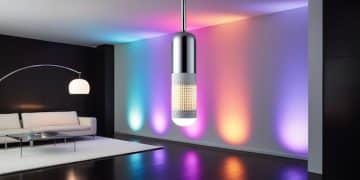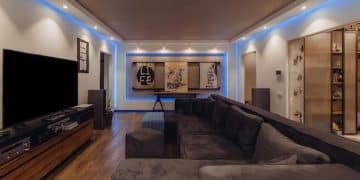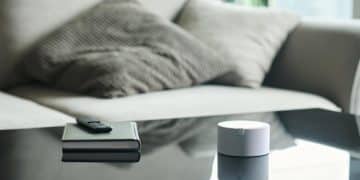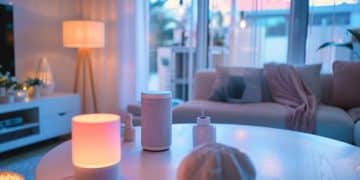Smart Home Lighting: Ambiance & Energy Savings with Smart Bulbs

Smart home lighting allows you to transform your living space by creating the perfect ambiance while saving energy through the use of smart bulbs, automated schedules, and personalized lighting scenes, enhancing both comfort and efficiency.
Imagine walking into your home and being greeted by the perfect lighting, tailored to the mood you desire, all while drastically reducing your energy bills. This is the promise of smart home lighting.
Understanding Smart Home Lighting
Smart home lighting systems are more than just a way to illuminate your home; they represent a convergence of comfort, convenience, and energy efficiency. By understanding the key components and benefits, you can make informed decisions about integrating smart lighting into your home.
What is Smart Lighting?
Smart lighting refers to a system of interconnected lighting devices within a home that can be controlled remotely. This includes smart bulbs, dimmers, switches, and even sensors that work together to automate and personalize your lighting experience.
Key Components of a Smart Lighting System
A typical smart lighting system consists of several essential components, each playing a unique role in the overall functionality.
- Smart Bulbs: These are energy-efficient bulbs with built-in Wi-Fi or Bluetooth connectivity.
- Smart Hub: A central control unit that connects all your smart devices.
- Mobile App: Allows you to control and customize your lighting from your smartphone.
- Smart Switches and Dimmers: Replace traditional switches and offer advanced control options.
Benefits of Switching to Smart Lighting
The advantages of smart lighting extend far beyond simple remote control. Here are some of the most compelling reasons to make the switch.
- Energy Savings: Smart bulbs consume significantly less energy than traditional incandescent bulbs.
- Customization: Adjust brightness, color, and set automated schedules to suit your needs.
- Convenience: Control your lights from anywhere using your smartphone.
- Security: Simulate occupancy when you’re away to deter intruders.
By understanding these foundational aspects of smart home lighting, you can begin to appreciate the potential it holds for transforming your living space. The next step is exploring the specific types of smart bulbs available and choosing the right ones for your home.
Choosing the Right Smart Bulbs
Selecting the appropriate smart bulbs is crucial for achieving the desired ambiance and energy efficiency in your home. With a variety of options available, understanding the key differences will help you make an informed decision.
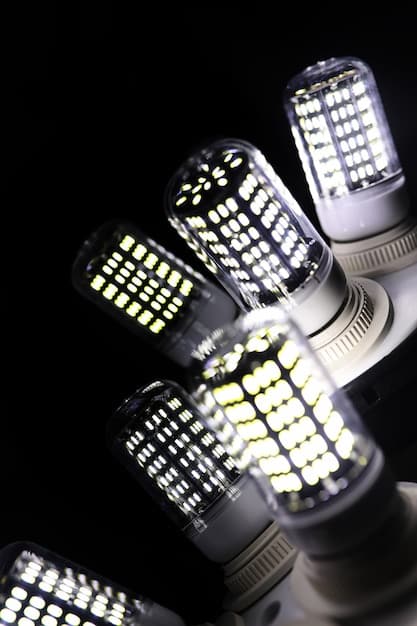
Types of Smart Bulbs Available
Smart bulbs come in various types, each with its own characteristics and applications.
- LED Bulbs: The most common type, known for their energy efficiency and long lifespan.
- Color-Changing Bulbs: Allow you to adjust the color temperature and hue of the light.
- Filament Bulbs: Offer a vintage aesthetic while still providing smart functionality.
Factors to Consider When Choosing Smart Bulbs
Several factors should influence your choice of smart bulbs. Consider the following aspects to ensure compatibility and performance:
- Brightness (Lumens): Choose the appropriate brightness level for each room.
- Color Temperature (Kelvin): Select the desired color temperature, from warm to cool.
- Connectivity (Wi-Fi, Bluetooth, Zigbee): Ensure compatibility with your smart home ecosystem.
Popular Smart Bulb Brands
Several reputable brands offer high-quality smart bulbs. Some of the most popular include:
- Philips Hue: Known for their extensive range of features and seamless integration.
- LIFX: Offers vibrant colors and high brightness levels.
- Wyze: Provides affordable options without sacrificing functionality.
Choosing the right smart bulbs involves careful consideration of your needs and preferences. By understanding the different types, factors, and brands available, you can create a smart lighting system that enhances your home’s ambiance and energy efficiency.
Setting Up Your Smart Lighting System
Setting up a smart lighting system might seem daunting at first, but with a step-by-step approach, it can be a straightforward process. Proper setup ensures that your smart bulbs and devices function seamlessly and effectively.
Step-by-Step Installation Guide
Follow these steps to install your smart lighting system:
- Download the App: Install the manufacturer’s app on your smartphone.
- Connect to the Hub: If required, connect the smart hub to your home network.
- Pair the Bulbs: Follow the app’s instructions to pair each bulb with the hub or directly to your Wi-Fi.
Connecting to Your Home Network
Connecting your smart lighting system to your home network is crucial for remote control and automation. Ensure that your Wi-Fi network is stable and secure.
Troubleshooting Common Issues
Even with careful setup, issues can sometimes arise. Here are some common problems and their solutions:
- Bulb Not Connecting: Ensure the bulb is within range of the hub or Wi-Fi signal.
- App Not Responding: Check your internet connection and restart the app.
- Hub Offline: Verify the hub’s power supply and network connection.
By following these steps and troubleshooting common issues, you can successfully set up your smart lighting system and begin enjoying its benefits. Remember to consult the manufacturer’s instructions for specific guidance.
Creating Ambiance with Smart Lighting
One of the most significant advantages of smart lighting is the ability to create customized ambiances. By adjusting brightness, color, and scene settings, you can transform your living space to suit any mood or occasion.
Adjusting Brightness and Color Temperature
Experimenting with brightness and color temperature is key to creating the perfect ambiance.
- Brightness: Lower brightness for a cozy atmosphere, higher for tasks requiring focus.
- Color Temperature: Warmer colors (2700-3000K) for relaxation, cooler colors (4000-5000K) for productivity.
Programming Lighting Scenes
Smart lighting systems allow you to create custom lighting scenes that can be activated with a single tap.
Examples of Lighting Scenes
Here are some examples of popular lighting scenes:
- Movie Night: Dims the lights and sets a warm color temperature for a cinematic experience.
- Reading Mode: Increases brightness and sets a cool color temperature for optimal focus.
- Party Mode: Cycles through various colors and brightness levels to create a festive atmosphere.
By mastering the art of creating ambiance with smart lighting, you can transform your home into a versatile and inviting space. Experiment with different settings and scenes to discover the perfect lighting for every moment.

Saving Energy with Smart Lighting
Beyond ambiance creation, smart home lighting offers significant energy-saving potential. By automating schedules, optimizing brightness, and utilizing motion sensors, you can reduce your energy consumption and lower your utility bills.
Automating Lighting Schedules
Automating your lighting schedules is a simple yet effective way to save energy. Set your lights to turn on and off automatically based on your daily routines.
Using Motion Sensors
Motion sensors can detect occupancy and automatically turn lights on or off, ensuring that lights are only on when needed.
Optimizing Brightness Levels
Adjusting brightness levels to the appropriate level can also save energy. Use dimming options to reduce brightness when full illumination is not necessary.
Benefits of Energy-Efficient Lighting
The cumulative effect of these energy-saving measures can be significant.
- Reduced Energy Consumption: Smart bulbs consume significantly less energy compared to traditional bulbs.
- Lower Utility Bills: Energy savings translate directly into lower monthly bills.
- Environmental Impact: Reducing energy consumption helps lower your carbon footprint.
By implementing these strategies, you can maximize the energy-saving potential of your smart lighting system and contribute to a more sustainable lifestyle.
Integrating Smart Lighting with Other Smart Home Devices
The true power of smart lighting is unleashed when integrated with other smart home devices. This seamless integration creates a cohesive and automated ecosystem that enhances both convenience and efficiency.
Connecting with Smart Speakers
Integrating your smart lighting with smart speakers like Amazon Echo or Google Home allows for voice control. Simply command your lights to turn on, off, or adjust brightness using your voice.
Integrating with Smart Security Systems
Smart lighting can also be integrated with smart security systems to enhance home security. Set your lights to automatically turn on when motion is detected outside, deterring potential intruders.
Creating an Automated Ecosystem
By integrating your smart lighting with other smart devices, you can create a fully automated home.
- Smart Thermostats: Adjust lighting based on temperature settings for optimal comfort.
- Smart Blinds: Coordinate lighting with window coverings to manage natural light levels.
- Smart Locks: Automate lighting based on door lock status for enhanced security.
The possibilities for integration are endless, allowing you to customize your smart home to meet your unique needs and preferences. As technology evolves, the potential for even more seamless and intuitive integration will continue to grow.
Smart home lighting offers a blend of ambiance control and energy efficiency. By choosing the best bulbs, understanding the setup process, and integrating with other devices, you can make your house smarter and more comfortable.
| Key Point | Brief Description |
|---|---|
| 💡 Smart Bulbs | Energy-efficient bulbs that can be controlled remotely. |
| 🔆 Ambiance | Create customizable lighting scenes with adjustable brightness and color. |
| 💰 Energy Savings | Automate schedules and use motion sensors to reduce energy consumption. |
| 🏡 Integration | Connect with smart speakers and security systems for comprehensive automation. |
Frequently Asked Questions
Smart home lighting offers energy savings, convenience through remote control, customizable ambiance, and enhanced security features. These benefits improve comfort and efficiency in your home.
Consider factors such as brightness (lumens), color temperature (Kelvin), and connectivity (Wi-Fi, Bluetooth, Zigbee) to ensure compatibility and performance. Also, choose reputable brands like Philips Hue or LIFX.
Yes, you can integrate your smart lighting system with smart speakers like Amazon Echo or Google Home, allowing you to control your lights using voice commands. This enhances convenience.
Smart lighting helps save energy by automating lighting schedules, using motion sensors to turn off lights when rooms are unoccupied, and optimizing brightness levels for different activities in the home.
Setting up a smart lighting system is generally straightforward. It involves downloading the manufacturer’s app, connecting to a smart hub if necessary, and pairing the bulbs with the hub or directly to your Wi-Fi network.
Conclusion
Smart home lighting presents an innovative way to enhance your living environment by creating personalized ambiances and reducing energy consumption. By embracing smart bulbs and other smart technologies, you can transform your home into a more comfortable, efficient, and secure space. As you explore the options available, remember that your choices should align with both your aesthetic preferences and your commitment to sustainability.
